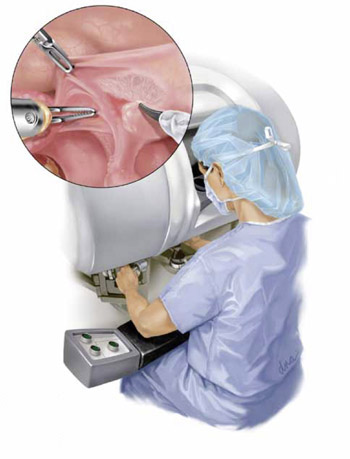Jamal Mourad, DO: I believe that the demand for minimally invasive procedures, including robotic-assisted surgeries, is multifaceted. The public has learned to have certain expectations about the care it receives. In addition, the media have incorporated a tremendous amount of information about minimally invasive surgery and robotic procedures into TV shows, newscasts, newspapers, and many other outlets. This information certainly stimulates, at the very least, curiosity on the part of the patient, which leads, in turn, to more inquiries about the robot during initial consultation with a surgeon.
Rosanne M. Kho, MD: Here at the Mayo Clinic in Arizona, we adopted use of the robot early. Following the lead of Javier Magrina, MD, we started with the Zeus system (Computer Motion) in 2003 and, subsequently, the da Vinci system (Intuitive Surgical) in 2004. At the time, not many data were available on the use of the robot in gynecology. We looked at the experience in urology and saw its applicability in gynecology. At our institution, therefore, our use of the robot was not driven by the market or data. It was primarily physician-driven and, fortunately, supported by our institution.
Jason D. Wright, MD: Demand for the robot stems from four different sources, in my opinion. Approximately 25% is patient-driven, 25% is surgeon-driven, 25% is hospital-driven, and let’s not forget industry—the makers of the robot—which accounts for 25% of demand. There is a delicate balance between all four buckets that is dynamic and always in flux. A shift too heavily in one direction can lead to problems, especially if variables such as proper infrastructure, outcomes data, or indications, just to name a few, are missing.
Marie Fidela R. Paraiso, MD: Many have criticized the marketing of robot-assisted surgery straight to the consumer. In fact, some investigators have found the claimed benefits of robotic surgery touted in marketing efforts by most hospitals to be unsubstantiated.3,4 That being said, hospitals market the robot to justify its cost and increase patient volume. And many surgeons who lack sufficient training or skill in advanced traditional laparoscopic surgery have embraced and marketed the robot platform as they have enhanced their surgical practices, converting open surgeries to minimally invasive procedures in the process. Patients are attracted to “new” procedures and equate them with “better” when they are choosing a physician or a procedure.
The demand for the robot is also physician driven. In my surgical armamentarium, I use this technology to do complex, multi-procedure pelvic floor repairs that require deep pelvic dissection and suturing or the addition of rectal prolapse procedures or retropubic space anti-incontinence procedures, with or without paravaginal repair.
OBG Management: What do the data reveal about robotic-assisted gynecologic surgery?
Marie Fidela R. Paraiso, MD: For benign conditions, data on robot-assisted laparoscopy are sparse and show no significant benefit, with higher cost and greater operative time than conventional laparoscopy in randomized trials.5,6 A Cochrane review and a large retrospective analysis support these findings.7,8 Another large retrospective study shows that robotic-assisted laparoscopy is associated with a shorter hospital stay, recovery time, postoperative time, and lower cost.9
Robotic surgery has proved to be beneficial in gynecologic oncology and has increased the use of minimally invasive access in gynecology, especially among novice or inexperienced minimally invasive surgeons. It also has helped some surgeons develop skills in advanced traditional laparoscopy.
Rosanne M. Kho, MD: Over the past 10 years in benign gynecology, retrospective comparative studies have found similar complication rates between the robotic approach and conventional laparoscopy. However, operative time and costs are higher in robotics.
One major advantage of the robot, demonstrated in multiple studies, is that the laparotomy rate for hysterectomy has declined in many centers and by as much as 14%, as Dr. Wright and his colleagues found, once the robotic platform becomes available.1

Are you using the robot more?
OBG Management: Has use of the robot increased at your institution?
Rosanne M. Kho, MD: With close to 10 years of experience with the robot, our utilization in gynecology is now stable—it’s neither increasing nor decreasing.
Cheryl B. Iglesia, MD: Yes, use of the robot at my institution has increased as more specialties have adapted the approach, including thoracic surgeons; ear, nose, and throat specialists; and colorectal surgeons. However, the majority of cases are either urologic or gynecologic in nature (urogynecology and gynecologic oncology).
Arnold P. Advincula, MD: This question is difficult to answer because, at Florida Hospital Celebration Health, we are a bit of an outlier. I function within a Global Robotics Institute that is dedicated to the safe and proper use of robotic technology by emphasizing optimal patient outcomes, teaching best practice techniques, and innovating future surgical platforms. Access is allowed for a limited number of surgeons in the various disciplines who are recognized pioneers and for high-volume surgeons with a proven track record of surgical outcomes. Our utilization across all disciplines, including gynecology, always has been high because of this infrastructure.


